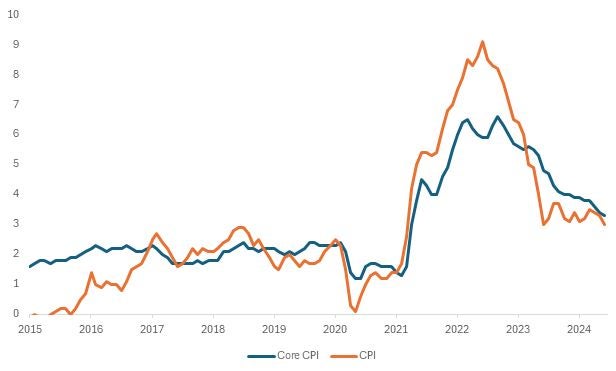Recent U.S. economic data indicates a continued slowdown in price increases, prompting many investors to consider a September Federal Reserve rate cut a near certainty. The equity market implications may be different than you expect.
Let’s look at the data. The U.S. headline consumer price index (CPI) fell to 3% year over year, while core CPI dropped to 3.3%. Not only are both figures below expectations, they also are the lowest headline and core CPI levels since June 2023 and April 2021, respectively. This decline is attributed to broad-based deflation in core goods, plus a notable 15 basis point decline in owners’ equivalent rent (OER)—which alone accounts for roughly one third of CPI. There are also signs of a cooling labor market in June’s slightly higher unemployment rate plus downward revisions in nonfarm payroll numbers. In response to these nuggets of good news, the market has rapidly bid up the odds of a Federal Reserve rate cut in September to 91%.

As of 07/15/24. Source: Bloomberg.
In the equity market, there has been a noticeable rotation away from tech momentum plays and into more rate-sensitive sectors. Following the CPI print, the Magnificent Seven collectively shed over half a trillion dollars in market cap, dragging down the tech-heavy Nasdaq and S&P 500. Meanwhile, indexes such as the small-cap Russell 2000 and mid-cap S&P 400 jumped after the worst start to the year relative to the S&P 500 in over 30 years. REITS, industrials, and utilities were also big beneficiaries of the rotation away from large-cap equities.
On a go-forward basis, we are questioning how much more money is to be made in U.S. equities by betting on a continued decline in inflation, as risks presently appear more balanced in this fluid economic situation. If investors are interested in additional areas of opportunity, in the U.S. we might suggest looking further down the cap scale or towards more value-oriented sectors, while internationally we are focusing on parts of Europe, particularly the U.K., as tactical opportunities.
Arjun Kaushik contributed to this article.

